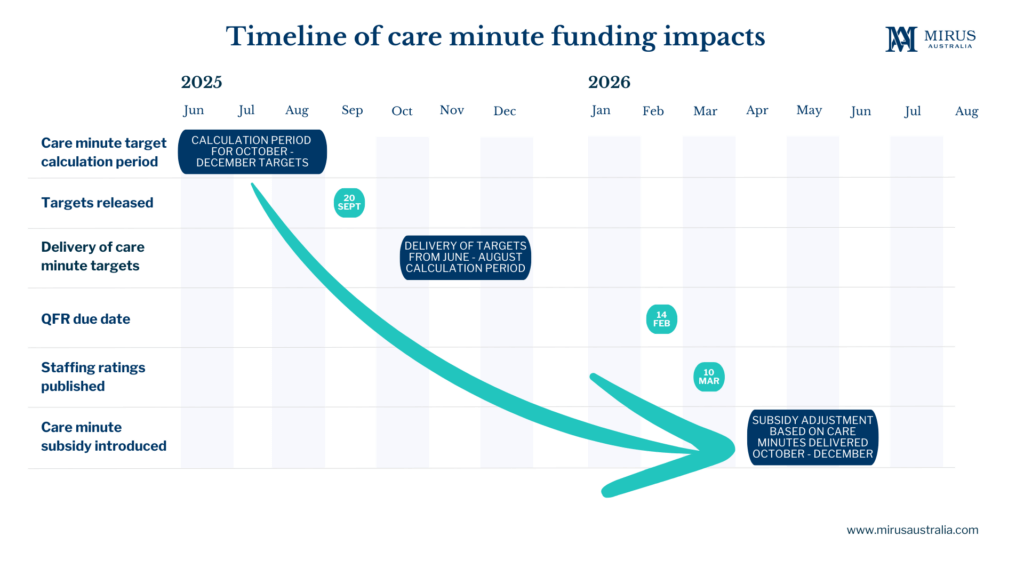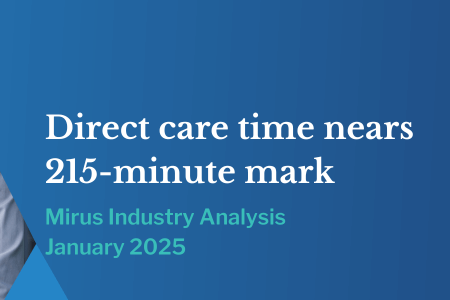What MM1 facilities need to know now about the 2026 Care Minute changes
January 31, 2025 | Care Minutes

By Andrew Farmer, CEO and Partner
The Department of Health and Aged Care’s recent announcement on care minute changes introduce significant challenges for MM1 facilities. From April 2026, a reduction in the Base Care Tariff will impact facilities not meeting the 215 care minute target. Our data indicates that this will impact more than 850 facilities.
While this 2026 date may seem distant, the calculation period for compliance is from June to August 2025, leaving providers less than six months to prepare. For MM1 facilities, proactive planning and cross-team collaboration are essential to mitigate funding reductions and meet care minute requirements.
Key changes in Care Minute funding
Starting April 2026, MM1 facilities that fail to meet the mandated care minute targets will see reductions in their Base Care Tariff. This funding decrease will operate on a sliding scale, with a maximum reduction of $31.64 per resident per day. The reductions will apply to both total care minutes and Registered Nurse (RN) minutes. A new Care Minute Supplement payment will be available, contingent on achieving compliance with these targets.

Key dates:
- June-August 2025 Calculation period to assess compliance.
- September 2025 Targets released
- October-December 2025 Delivery of targets from June to August calculation period.
- February 2026 QFR due
- April 2026 Adjusted subsidy implementation of reduced Base Care Tariff and Care Minute Supplement.
The Financial and Operational impact
For facilities operating on tight margins, the potential funding reduction could have a profound impact. A reduction of up to $31.64 per resident per day equates to a significant financial shortfall, which could hinder the ability to deliver quality care. Additionally, the dual focus on total care minutes and RN minutes introduces operational complexity, requiring careful planning and execution.
Why acting now is so important
Although April 2026 might seem far away, the six-month window leading up to the compliance calculation period is deceptively short. To meet the June-August 2025 requirements, providers must:
- Assess current care minute performance against targets.
- Strategise resource allocation to bridge any gaps.
- Implement workflows to ensure ongoing compliance.
Providers who delay may find themselves scrambling to align funding and rostering, risking both financial penalties and compromised care quality.
Collaboration and communication between funding and rostering teams are key to success
Meeting care minute targets is not solely the responsibility of one team. Success requires seamless communication between funding and rostering teams to align care capacity with resident needs. This alignment involves:
- Data-driven decision-making: Understanding the impact of in-situ resident AN-ACC classifications and new admissions on care minute requirements.
- Scenario planning: Evaluating multiple staffing scenarios to identify the optimal approach for meeting targets.
- Real-time reporting: Monitoring performance against targets to ensure timely adjustments.
Steps to take now to prepare for the change
To position your facility for success, consider these action steps:
- Audit current performance: Use historical data to evaluate your current care minute performance and identify gaps.
- Build cross-team synergy: Establish regular communication between funding and rostering teams to align goals and strategies.
- Invest in tools: Leverage technology like Mirus Metrics to enhance planning, forecasting, and reporting.
- Monitor resident classifications: Regularly review in-situ resident AN-ACC classifications and new admissions to stay ahead of changes.
- Develop a contingency plan: Prepare for unforeseen challenges by exploring multiple staffing and funding scenarios.
The care minute changes represent both a challenge and an opportunity for MM1 facilities. By acting decisively and leveraging the right tools, providers can not only achieve compliance but also strengthen their operational resilience. The countdown to compliance has already begun – now is the time to prepare.
To learn how Mirus Metrics can help your facility meet the 215 care minute target and optimise your funding strategy, Contact us today for a demo and take the first step toward compliance with confidence.
Designed to streamline workflows and provide actionable insights, Mirus Metrics enables:
- Scenario Planning: Accurately forecast care minute capacity based on resident classifications and anticipated changes.
- Team Collaboration: Facilitate seamless communication between funding and rostering teams with shared data and tools.
- Executive Oversight: Deliver transparent reporting to support informed decision-making at the leadership level.
With Mirus Metrics, providers can proactively address gaps, optimise resource allocation, and ensure compliance with care minute requirements. Get a demo today.


